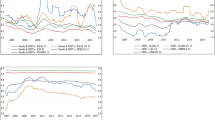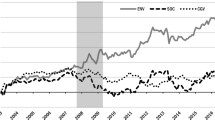Abstract
This study explores the effectiveness of entropy as a proxy of aggregate market risk, in explaining the cross-section of excess returns in asset pricing model, after controlling for established factors like market excess returns, size, book to market and momentum. The analysis considers Indian firms, given that Indian capital markets are characterized by relatively thin trading and higher volatility compared to developed markets. Entropy is estimated using Shannon Entropy. Factor mimicking portfolio is constructed based on Shannon Entropy, whose returns are used as additional risk factor in Fama–French–Carhart four factor asset pricing model. Gibbons Ross Shanken-F statistic and Adjusted R2 are used to judge the efficacy of this factor in capital asset pricing model. All analysis is done using built in functions of python. Market beta, size and Book-to-Market are found to impact equity returns significantly. Entropy factor also impacts equity returns, but to a lesser extent. Explanatory power of asset pricing model is found to improve after inclusion of entropy factor, as indicated by GRS-F Statistic and Adjusted R2. Entropy augmented Capital Asset Pricing Models can be used by firms to decide hurdle rate for project evaluation and by asset managers for identifying over-valued/under-valued securities. This is the first study that investigates the role of entropy in explaining asset returns, in addition to other established priced factors. This study is limited to Shannon Entropy only. Other forms of entropy may improve results further, and should be explored in future research.


Similar content being viewed by others
Data Availability
DataFiles for Fama–French and momentum factor for Indian Markets (http://faculty.iima.ac.in/~iffm/Indian-Fama-French-Momentum/). Library to extract data from NSE Website (https://nsepy.readthedocs.io).
Notes
Ang et al. (2006) show that high volatility stocks offer 1% lower return than low volatility stocks on an average, and this difference is statistically significant. Further, this difference exists even after accounting for known factors like size, book-to-market, momentum and liquidity effects.
References
Adrian, T & Rosenberg, J. (2008). Stock returns and volatility: pricing the short-run and long-run components of market risk. The Journal of Finance, 63, 2997–3030. https://doi.org/10.1111/j.1540-6261.2008.01419.x.
Ahmadi-Javid, A., & Fallah-Tafti, M. (2019). Portfolio optimization with entropic value-at-risk. European Journal of Operational Research, 279(1), 225–241.
Ang, A., Hodrick, R. J., Xing, Y., & Zhang, X. (2006). The cross-section of volatility and expected returns. Journal of Finance, 61(1), 259–299.
Ang, A., Liu, J., & Schwarz, K. (2019). Using stocks or portfolios in tests of factor models. Journal of Financial and Quantitative Analysis. https://doi.org/10.1017/S0022109019000255
Ardakani, O. M. (2022). Option pricing with maximum entropy densities: The inclusion of higher-order moments. Journal of Futures Markets., 42(10), 1821–1836.
Backus, D., Chernov, M., & Zin, S. (2013). Sources of entropy in representative agent models. Journal of Finance, 69(1), 51–99.
Bagchi, D. (2007). An analysis of relative information content of volatility measures of stock index in India. ICFAI Journal of Derivatives Markets, 4(4), 35–43.
Bakshi, G., & Chabi-Yo, F. (2019). New entropy restrictions and the quest for better-specified asset-pricing models. Journal of Financial & Quantitative Analysis, 54(6), 2517–2541.
Banerjee, P. S., Doran, J. S., & Peterson, D. R. (2007). Implied volatility and future portfolio returns. Journal of Banking & Finance, 31(10), 3183–3199.
Bekiros, S., & Marcellino, M. (2013). The multiscale causal dynamics of foreign exchange markets. Journal of International Money and Finance, 38, 282–305.
Benedetto, F., Mastroeni, L., & Vellucci, P. (2021). Modeling the flow of information between financial time-series by an entropy-based approach. Annals of Operations Research, 299(1/2), 1235–1252.
Bentes, S., & Menezes, R. (2012). Entropy: A new measure of stock market volatility. Journal of Physics: Conference Series, 394(1), 12–33.
Bensaida, A., Hernandez, J. A., Litimi, H., & Yoon, S.-M. (2022). The influence of oil, gold and stock market index on US equity sectors. Applied Economics, 54(6), 719–732.
Bowden, R. J. (2011). Directional entropy and tail uncertainty, with applications to financial hazard. Quantitative Finance, 11(3), 437–446.
Campbell, J. Y., Giglio, S., Polk, C., & Turley, R. (2018). An intertemporal CAPM with stochastic volatility. Journal of Financial Economics, 128(2), 207–233.
Carhart, M. M. (1997). On persistence in mutual fund performance. Journal of Finance, 52(1), 57–82.
Chen, J. S. (2002). Intertemporal CAPM and the cross-section of stock returns. EFA 2002 Berlin Meetings Discussion Paper, Available at SSRN: https://ssrn.com/abstract=301918 or https://doi.org/10.2139/ssrn.301918.
Cheng, I.-H. (2019). The VIX premium. Review of Financial Studies, 32(1), 180–227.
Chon, S., & Kim, J. (2021). Does the financial leverage effect depend on volatility regimes? Finance Research Letters, 39(1–7), 101600.
D’Amico, G., Gismondi, F., Petroni, F., & Prattico, F. (2019). Stock market daily volatility and information measures of predictability. Physica a: Statistical Mechanics and Its Applications, 518(C), 22–29.
Delisle, R. J., Doran, J. S., & Peterson, D. R. (2011). Asymmetric pricing of implied systematic volatility in the cross-section of expected returns. Journal of Futures Markets, 31(1), 34–54.
Dimpfl, T., & Franziska, J. P. (2018). Analyzing volatility transmission using group transfer entropy. Energy Economics, 75(C), 368–376.
Dionisio, A., Menezes, R., & Mendes, D. A. (2006). An econophysics approach to analyse uncertainty in financial markets: an application to the Portuguese stock market. The European Physical Journal B Condensed Matter and Complex Systems, 50(1–2), 161–164. https://doi.org/10.1140/epjb/e2006-00113-2
Durand, R. B., Lim, D., & Zumwalt, J. K. (2011). Fear and the Fama-French factors. Financial Management, 40(2), 409–426.
Efremidze, L., Stanley, D. J., & Kinsman, M. (2015). Stock market timing with entropy. Journal of Wealth Management, 18(3), 57–67. https://doi.org/10.3905/jwm.2015.18.3.057
Efremidze, L., Stanley, D. J., & Kownatzki, C. (2021). Entropy trading strategies reveal inefficiencies in Japanese stock market. International Review of Economics & Finance, 75, 464–477.
Elsayed, A. H., Gozgor, G., & Chi, K. M. (2022). Risk transmissions between bitcoin and traditional financial assets during the COVID-19 era: The role of global uncertainties. International Review of Financial Analysis. https://doi.org/10.1016/j.irfa.2022.102069
Fama, E. F., & French, K. R. (1992). The cross-section of expected stock returns. Journal of Finance, 47, 427–465.
Fama, E. F., & French, K. R. (1993). Common risk factors in the returns on stocks and bonds. Journal of Financial Economics, 33(1), 3–56.
Fama, E. F., & French, K. R. (1996). Multifactor explanation of asset pricing anomalies. Journal of Finance, 51(1), 55–84.
Fama, E. F., & French, K. R. (2016). Dissecting anomalies with a five factor model. Review of Financial Studies., 29(1), 69–103.
Fama, E. F., & MacBeth, J. D. (1973). Risk, return, and equilibrium: Empirical tests. Journal of Political Economy, 71, 607–636.
García-Feijóo, L., & Viale, A. M. (2022). A simple robust asset pricing model under statistical ambiguity. Quantitative Finance, 22(5), 861–869.
Gibbons, M. R., Ross, S. A., & Shanken, J. (1989). A test of the efficiency of a given portfolio. Econometrica, 57(5), 1121–1152.
GRS Review, Diether, K., University of Chicago Graduate School of Business http://faculty.chicagobooth.edu/eugene.fama/teaching/Reading%20List%20and%20Notes/GRS.pdf
Gradojevic, N., & Caric, M. (2017). Predicting systemic risk with entropic indicators. Journal of Forecasting, 36, 16–25.
Grauer, R. R., & Janmaat, J. A. (2004). The unintended consequences of grouping in tests of asset pricing models. Journal of Banking and Finance, 28, 2889–2914.
Hitz, L., Mustafi, I. H., & Zimmermann, H. (2022). The pricing of volatility risk in the US equity market. International Review of Financial Analysis. https://doi.org/10.1016/j.irfa.2021.101951
Jayawardena, N. I., Todorova, N., Li, B., Su, J.-J., & Gau, Y.-F. (2022). Risk-return trade-off in the Australian Securities Exchange: Accounting for overnight effects, realized higher moments, long-run relations, and fractional cointegration. International Review of Economics & Finance, 80, 384–401.
Jing-Rung, Y., Wan-Jiun, P. C., Wen-Yi, L., & Kai-Cheng, Y. (2017). Does entropy model with return forecasting enhance portfolio performance? Computers & Industrial Engineering, 114, 175–182.
Jiang, L., Wu, K., & Zhou, G. (2018). Asymmetry in stock comovements: An entropy approach. Journal of Financial & Quantitative Analysis, 53(4), 1479–1507.
Kan, R. (2004). On the Explanatory power of Asset Pricing Models Across and Within Portfolios. Working paper, University of Toronto
Kothari, S. P., Shanken, J., & Sloan, R. G. (1995). Another look at the crosssection of expected stock return. Journal of Finance, 50(1), 185–224.
Kumar, S., & Rao, K. N. (2014). Are fear and inertia subsumed in Fama-French three factor model? International Economics and Finance Journal, 9(1), 23–37.
Kussy, M. (2017). Current volatility as a measure of market risk. International Journal of Risk Assessment & Management, 20(4), 333–349.
Labidi, C., & Yaakoubi, S. (2016). Investor sentiment and aggregate volatility pricing. The Quarterly Review of Economics and Finance, 61, 53–63.
Lee, W., Park, J. L. & Sohn, B. (2021). Aggregate volatility risk and empirical factors: An international study. Emerging Markets Finance & Trade, 57(5), 1489–1513. https://doi.org/10.1080/1540496X.2019.1633305.
Lewellen, J., Nagel, S., & Shanken, J. (2010). A skeptical appraisal of asset-pricing tests. Journal of Financial Economics, 96, 175–194.
Lintner, J. (1965). Security prices, risk, and maximal gains from diversification. Journal of Finance, 20(4), 587–615.
Lo, A. W., & MacKinlay, A. C. (1990). When are contrarian profits due to stock market overreaction? Review of Financial Studies, 3(2), 175–205.
Lochstoer, L. A., & Tyler, M. (2022). Volatility expectations and returns. Journal of Finance., 77(2), 1055–1096.
Mai, V. A. V., Ang, T. C. C., & Fang, V. (2016). Aggregate volatility risk and the cross-section of stock returns: Australian evidence. Pacific-Basin Finance Journal, 36, 134–149.
Otaify, M. (2022). Modeling volatility of size, value and financial leverage-sorted portfolios: Evidence from Egyptian stock exchange. Journal of Public Affairs, 22(2), 1–16.
Ormos, M., & Zibriczky, D. (2014). Entropy-based financial asset pricing. Available at. https://doi.org/10.1371/journal.pone.0115742
Pati, P. C., Rajib, P., & Barai, P. (2019). The role of the volatility index in asset pricing: The case of the Indian stock market. The Quarterly Review of Economics and Finance. https://doi.org/10.1016/j.qref.2019.04.010
Pichler, A., & Schlotter, R. (2019). Entropy based risk measures. European Journal of Operational Research, Forthcoming
Rahman, S., & Schneider, M. J. (2019). Tests of alternative asset pricing models using individual security returns and a new multivariate F-test. Review of Pacific Basin Financial Markets & Policies, 22(1), 1–34.
Rocciolo, F., Gheno, A., & Brooks, C. (2022). Explaining abnormal returns in stock markets: An alpha-neutral version of the CAPM. International Review of Financial Analysis. https://doi.org/10.1016/j.irfa.2022.102143
Sabbaghi, O. (2015). Volatility, distress risk, and the cross-section of portfolio returns. Review of Accounting and Finance, 14(2), 149–171.
Shannon, C. E. (1948). A mathematical theory of communication. Bell System Technical Journal, 27, 379–423.
Sharpe, W. F. (1964). Capital asset prices: A theory of market equilibrium under conditions of risk. Journal of Finance., 19(3), 425–442.
Sheraz, M., Dedu, S., & Preda, V. (2015). Entropy measures for assessing volatile markets. Procedia Economics and Finance, 22, 655–663.
Smales, L. A. (2022). Spreading the fear: The central role of CBOE VIX in global stock market uncertainty. Global Finance Journal. https://doi.org/10.1016/j.gfj.2021.100679
Smith, K. C., & So, E. C. (2022). Measuring risk information. Journal of Accounting Research, 60(2), 375–426.
Sohn, B (2009). Cross-section of equity returns: Stock market volatility and priced factors. Available at SSRN: https://ssrn.com/abstract=1364834 or https://doi.org/10.2139/ssrn.1364834.
Stutzer, M. J. (2000). Simple entropic derivation of a generalized Black-Scholes option pricing model. Entropy, 2, 70–77.
Whaley, R. E. (1993). Derivatives on market volatility: Hedging tools long overdue. Journal of Derivatives, 1(1), 71–84.
Author information
Authors and Affiliations
Corresponding author
Additional information
Publisher's Note
Springer Nature remains neutral with regard to jurisdictional claims in published maps and institutional affiliations.
Rights and permissions
Springer Nature or its licensor (e.g. a society or other partner) holds exclusive rights to this article under a publishing agreement with the author(s) or other rightsholder(s); author self-archiving of the accepted manuscript version of this article is solely governed by the terms of such publishing agreement and applicable law.
About this article
Cite this article
Mishra, H., Barai, P. Entropy Augmented Asset Pricing Model: Study on Indian Stock Market. Asia-Pac Financ Markets 31, 81–99 (2024). https://doi.org/10.1007/s10690-023-09407-w
Accepted:
Published:
Issue Date:
DOI: https://doi.org/10.1007/s10690-023-09407-w




